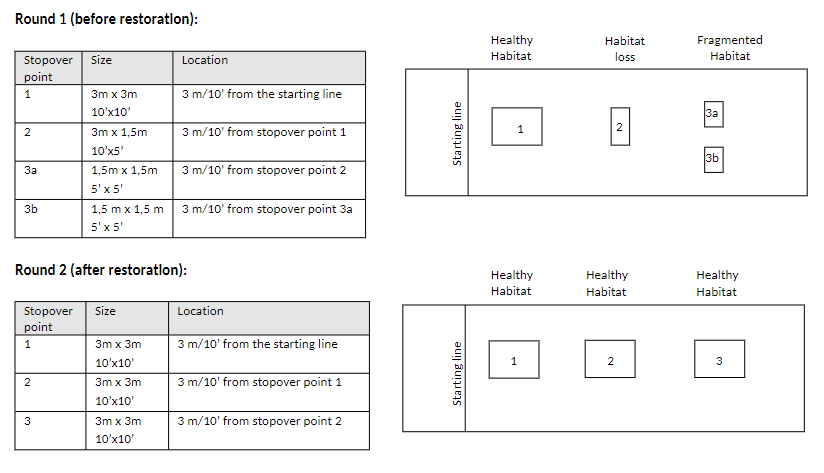This game demonstrates the positive effects of conservation on habitat loss and fragmentation. Students try to get their birds (paper airplanes) to successfully complete their migration journey. Who will make it to their final destination?

Grade level: K-3
Learning Objectives:
– Identify the effects of habitat loss and fragmentation
– Recognize the importance of conservation and restoration projects
During this activity, students will:
– Observe how habitat loss and fragmentation impact migrating birds
– Learn about examples of successful conservation projects
– Write a persuasive letter to an elected official
Materials:
– Access to a gymnasium or large playing area
– Masking tape
– Recycled or scrap letter sized (8.5”x11”) paper for the airplanes
Birds face a number of challenges as they make their annual trips to and from their wintering grounds, including the continued habitat loss and fragmentation at critical migration stopover sites.
Many species depend on the wetlands of the Prairie Pothole Region to nest and feed. It encompasses over 700,000 km2 and extends across three provinces and five American states. In some parts of the region, up to 70% of the wetlands have disappeared due to human activity. However, thanks to conservation and restoration efforts, there are zones that have returned to their healthy state. If we continue to take action, we can save this region for generations to come.
In this game, to make it to their final destination, students must reach each of the three Prairie Potholes. In the first round, the stopover sites will become smaller and more fragmented. In the second, they will be larger and easier to reach. This will help the students visualize the importance of conservation work.
After talking about several examples of successful conservation projects, the students write to a local elected official to share their passion for the environment and to inspire action.
Set up:
- Prepare the paper for the airplanes. The videos below can help with making airplanes:
• The Easy and Classic Paper Airplane – The Basic Dart (Fold ‘N Fly)
• How to Make a Paper Airplane (innerchildfunmedia) - Set up the playing space using the dimensions and the images as a guide. You can adapt the size and location of the stopover points to the space you have.

Instructions
1. Begin by asking the students what they know about migration. The following questions can be used as a guide:
• What is migration? What kinds of animals migrate?
• Why do birds migrate? (Some migrate because of cold weather/better habitat, some for food, some for mating)
• What do birds need as they migrate?
2. Explain that birds need specific spaces to stop to feed. Introduce The Prairie Pothole Region. Show a map and explain that it touches three provinces and five states, covering over 700,000 km2. Explain that it is an area where birds stop during migration to feed.
3. Tell the students that today you will be playing a game to see what it is like for a migrating bird looking for a rest. Explain the rules of the game:
We will be playing this game in the gym. Birds will have to successfully land at three different Prairie Potholes stopover points. The birds will be paper airplanes that you have made.
From the starting line, each of you will throw your paper airplane towards the first stopover point (several students will throw their planes at the same time). We will count the number of planes that make it to the first stop. If your plane doesn’t make it, you will sit out for the next step.
Next, we will use the first stopover point as our starting line. You will throw your airplanes towards the second stopover point. We will count the number of planes that make it to the second stop. If your plane doesn’t make it, you will sit out for the next step.
From the second stopover point, those left in the game will throw their planes towards the third stopover point. There are two possible landing points and you can aim for either one. We will count the number of birds that make it to the third and final stopover point.
We will play the game twice. The second time, the stopover points will be a bit different.
But first, let’s make our “birds”.
4. Distribute the paper to the students and, if required, show them how to make the paper airplanes. Make sure every student writes their name on their airplane. If time allows, students can decorate their airplanes to make them look like birds.
5. Once the airplanes are ready, go to the gym.
6. Review the rules and begin the game! Once both rounds have been played, return to the classroom.
Discussion
1. On the board, write down the number of birds having made it to each stopover point for each round. Discuss the game using the following guiding questions:
• What did this game make you think about?
• Which round was easier? Why?
Explain that in the first round, the stopover points were affected by habitat loss and fragmentation, whereas in the second round, the stopover points had been restored thanks to conservation projects. Continue the discussion:
• Why is it important to take care of the Prairie Pothole Region?
• Can you think of any examples of other systems in which habitat loss has had a significant impact on wildlife? (For example, construction zones for new buildings or roads)
2. Share the following examples of conservation projects underlining that it is possible to make a positive difference!
Canadian prairies and the swift fox:
Swift foxes disappeared from Canada around the 1930s, after so much of the grassland where they lived was turned into farmland. But in the 1980s and 90s they were reintroduced, so Canada now has a more stable population. Talk about making a comeback! Earth Rangers is working with Peter Soroye from the Wildlife Conservation Society of Canada (WCS) to continue to protect prairie grasslands so that the Swift fox is no longer endangered and we can see its population, which is currently around 300, grow.
The American Badger: Earth Rangers is working with the Nature Conservancy Canada (NCC) on a restoration project that will improve badger habitat on a 1,600-hectare property in British Columbia called Kootenay River Ranch. This conservation area is home to some of the country’s remaining American badgers (with fewer than an estimated 4,000 in the wild across Canada), which is why it’s so important to make it a safe home for these animals. The conservation area contains a large stretch of open forests and grasslands and about 25% of the land has already improved through restoration. It’s well on its way to becoming even better badger habitat.
3. Talk about conservation projects:
• Do you know of any other conservation projects?
• Can you think of any habitats around here that need to be conserved?
• How can we help people understand the importance of habitat conservation?
Next step
Building off everything shared in the discussion stage, have the students write a letter to an elected official, individually or as a group.
First, students choose a region that they think is important to protect. After researching the environmental issues in this area, students write a letter to an elected official (for example, the federal, provincial or territorial minister of the environment, the mayor, etc.) to share their passion for the environment and to inspire action.
Their letter should be positive and inspiring and should contain the following key elements:
• An overview of the issue – what is habitat loss and fragmentation? Why is it a problem?
• An example of an animal affected by habitat loss
• A broad call to action (eg. “Please do your part to help protect habitats”)
Another way to contribute to conservation efforts is adopting an animal, like the Swift Fox or the American Badger through the Earth Rangers Wildlife Adoption program. This program directly supports the conservation work of many Canadian researchers.
Resources
Prairie Pothole Region:
Prairie Pothole Region (Ducks Unlimited Canada)
Migratory Birds:
How do birds know it is time to migrate? (Earth Rangers)
Top Ten Largest Migratory Birds in Canada (Earth Rangers)
Migration: A perilous journey (Ducks Unlimited Canada)
